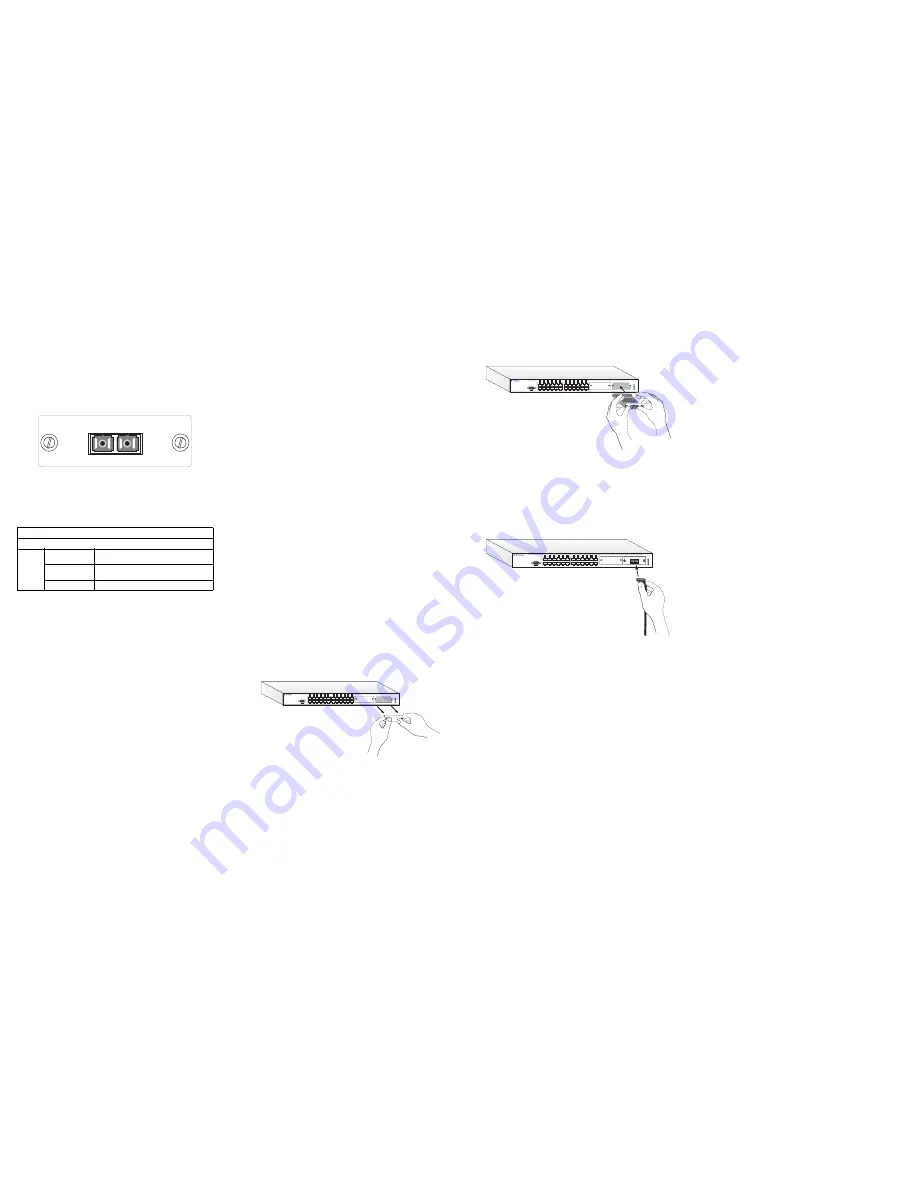
WORKGROUP SWITCH
1000BASE-SX GIGABIT
ETHERNET UPLINK MODULE
Hirschmann’s LION-GIGA-1SX 1000Base-SX SC
Gigabit Ethernet Uplink Module provides a short
wavelength (850 nm) Gigabit port that can be used for
a high-speed backbone or server connections. It
contains one 1000Base-SX port that can be connected
to a site up to 550 m (1805 ft) away with fiber cable.
Module Port LEDs
Port LEDs for the module are located on the front panel
of the switch. These LEDs provide port status for “at-a-
glance” network monitoring. The following table details
the indicator functions provided by the LION-24TP:
INSTALLING THE MODULE
CAUTION:
The LION-GIGA-1SX module is designed for
the LION-24TP switch only. Do not try to install this
module in any other units.
The LION-GIGA-1SX Uplink Module installs in either of
the two front panel slots on the LION-24TP switch. To
install the module, follow the instructions below.
Equipment Checklist
After unpacking the LION-GIGA-1SX Uplink Module,
check the contents of the box to be sure you’ve received
the following items:
• One
LION-GIGA-1SX
Uplink Module
• This document
Handling the Module
CAUTION:
The LION-GIGA-1SX Uplink Module can
easily be damaged by electrostatic discharge.
To prevent electrostatic damage, observe the following
guidelines:
• Do not remove the module from its packaging until you
are ready to install it.
• Do not touch any of the module’s pins, connectors or
components.
• Hold the module only by its edges or front panel.
• Wear an anti-static wristband connected to a suitable
earth ground whenever handling the module.
• Store or transport this module only in appropriate anti-
static packaging.
Instructions
CAUTION:
The switch must be powered off before
installing or replacing any module.
1.
Power off the switch:
Disconnect the AC power
cord from the switch.
2.
Remove network cables:
If you are replacing a
module, remove the cable attached to the port on
the module.
3.
Loosen the screws on the installed module or
slot faceplate:
Using your fingers or a flathead
screwdriver, turn the screws securing the module
(or faceplate on the slot) in a counter-clockwise
direction until they are free of the chassis. Be sure
not to completely remove the screws from the
module or faceplate.
4.
Remove the installed module or faceplate:
Firmly pull on the screws until the module is free of
the switch. Carefully slide the module straight out of
the slot.
Keep the original faceplate for future use. If you
should remove the module, replace the faceplate to
prevent dust and debris from entering the unit and
to maintain proper air flow.
5.
Insert the new module into the switch:
Holding the new module with the text on the front
panel upright, carefully slide the module into the
switch slot and press gently until it snaps into place.
Be sure the new module’s front panel is flush with
the switch panel.
6.
Secure the new module:
Secure the new module
in place by screwing the attached screws clockwise
into the switch’s chassis. Tighten them enough to
secure the module, but not so tight as to prevent
them from being unscrewed by hand.
7.
Connect the network cable:
Connect fiber cable
to the port on the newly installed module. See
“Connectivity Guidelines” in this guide for further
information.
8.
Power on the switch:
Reconnect the previously
removed power sources to the switch. The switch’s
front-panel LEDs should indicate the status of the
new connection. Check the LED indicator for the
fiber port to ensure that it is operating correctly.
Refer to the table of LEDs in this guide for a
description of the LED indications. If the module
does not respond, see “Troubleshooting” below.
More details concerning connection options and
network applications can be found in the LION-24TP
User Guide. Information on the module’s configuration
options can be found in the Management Guide that is
included with the base unit.
TROUBLESHOOTING
If you experience any problems with the module, check
the following items before contacting Hirschmann’s
Technical Support:
• Ensure the
LION-24TP
switch with the Gigabit
Ethernet Uplink Module is powered up.
• Ensure that the device attached to the module is
powered up and operating correctly.
• Ensure that the module is properly seated in the slot.
• Verify that the attached device is configured to match
the communication mode used by the module (that is,
1 Gbps, full duplex).
• Check the connectors on both ends of the cable to be
sure they are properly engaged. When attaching fiber
cable to an SC-type port, be sure the plug clicks into
place to ensure that it is properly seated.
• Be sure the fiber terminators are clean. You can clean
the cable plugs by wiping them gently with a clean
tissue or cotton ball moistened with a little ethanol.
Dirty fiber terminators on fiber optic cables will impair
the quality of the light transmitted through the cable.
Uplink Module LEDs
LED
Condition
Status
M1, M2
On/Flashing Amber
Port has established a valid 10/100 Mbps network
connection. Flashing indicates activity.
On/Flashing Green
Port has established a valid 1000 Mbps network
connection. Flashing indicates activity.
Off
There is no valid link on the port.
RX
TX
Gigabit Uplink Module
LION-GIGA-1SX
Console
M1
M2
Power
M1
M2
Diag
1
5
7
9
11
13
15
17
19
21
23
3
2
6
8
10
12
14
16
18
20
22
24
4
LION-24TP
Console
M1
M2
Power
M1
M2
Diag
1
5
7
9
11
13
15
17
19
21
23
3
2
6
8
10
12
14
16
18
20
22
24
4
LION-24TP
RX
TX
Console
M1
M2
Power
M1
M2
Diag
1
5
7
9
11
13
15
17
19
21
23
3
2
6
8
10
12
14
16
18
20
22
24
4
LION-24TP
RX
TX
Gigabit Uplink Module
LION-GIGA-1SX


